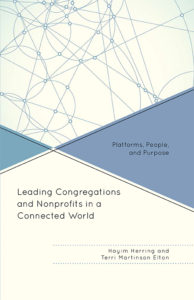The Past and Future of Congregations and Nonprofits
When the values of a congregation or nonprofit are out of sync with the values of their stakeholders, we have a recipe for frustration between individual and institution. Congregations and nonprofits live by two sets of values: their stated interpersonal values, and their embedded organizational values. Their interpersonal values, framed in Jewish values language, guide how community members are expected to relate to one. They are often explicitly codified in an approved organizational “values statement.”
Organizational values are expressed through leaders’ responses to policy changes, programs and initiatives. For example, how a congregation or nonprofit responds to trends like “fee for service” or “donor directed giving” provides insights into organizational values about customer service, experimentation and agility. But organizational values are so embedded that they are invisible to those who work in or regularly volunteer for them. They only become apparent when the values of congregations or nonprofits are misaligned with the values of their stakeholders. And until leaders and stakeholders realign their organizational values, it’s unsatisfying for both sides.
In Leading Congregations in a Connected World: Platform, People and Purpose, a book that I co-wrote with Dr. Terri Elton, Associate Professor Leadership at Luther Seminary, we trace a brief, three-stage history of faith-based organizations and their embedded organizational values. Being aware of these values can help or hinder deeper relationships between congregations or nonprofits and constituents. These three stages are:
Organization 1.0: the “benign parent” or hierarchical model, where decisions are made thoughtfully and caringly by a small leadership group at the top for a larger less “informed” group below.
Organization 2.0: a version of the above that creates a parallel presence of the organization on the web, but still is basically a one-way channel for broadcasting the congregation’s or nonprofit’s message with little meaningful room for engagement with members. Many established congregations and faith-based nonprofits are still organized as 2.0.
Organization 3.0: a blended model of hierarchy and networks that is present both in digital and physical space, characterized by dialogue, more shared-decision making and creation of content and meaning. It values are based on deep engagement between individuals and organizations. (Spoiler alert: on page 11 we even give the date on which Organization 3.0 first became possible—June 29, 2007.)
The fundamental difference between Congregation or Nonprofit 2.0 and 3.0 is an acknowledgement that that individuals do not need existing organizations to express and explore sacred meaning and purpose. They have the ability to bypass them and find or create new platforms to do so. But if congregations and nonprofits can make the pivot and become platforms for people to engage in purposeful work, they have a good chance of engaging new and existing audiences more deeply. Unlike startups, they have the advantage of doing so in physical and digital space.
To learn more about how emerging and established congregations and nonprofits in the Jewish and Protestant communities are becoming more “3.0,” we hope that you’ll purchase our book, which you can still do at a 40% time limited discount by using the code RL40LC16 when ordering. And connect with me (options for social media of your choice, top right) to explore trends like the implications of virtual reality for congregational and nonprofit communities. It looks like we’re quickly moving from gathering in “stained glass” spaces to meeting in virtual space, thanks to the affordability of virtual and augmented reality glasses. Time to start thinking about how congregations and nonprofits can shape that trend to help them increase their impact!
 We see a significant role for congregations and nonprofits around the issue of community. But given how fragile and complex community is today, we believe that congregations will benefit by learning from one another. One opportunity for shared learning is in gaining greater understanding about the limits of digital space in engaging members and participants. What kinds of “conversations” are effective on digital platforms and which are best held in a physical space? What happens when a professional or volunteer publishes information about an issue that is unintentionally misleading or inaccurate—or simply false? One of clergy leader in our study framed the issue this way. He said that for now, he’ll take an old-fashioned town hall meeting about an important issue over a digital discussion because “there’s an accountability piece missing” online. When people don’t have to make eye contact with one another, they have to grapple with the impact of their words.
We see a significant role for congregations and nonprofits around the issue of community. But given how fragile and complex community is today, we believe that congregations will benefit by learning from one another. One opportunity for shared learning is in gaining greater understanding about the limits of digital space in engaging members and participants. What kinds of “conversations” are effective on digital platforms and which are best held in a physical space? What happens when a professional or volunteer publishes information about an issue that is unintentionally misleading or inaccurate—or simply false? One of clergy leader in our study framed the issue this way. He said that for now, he’ll take an old-fashioned town hall meeting about an important issue over a digital discussion because “there’s an accountability piece missing” online. When people don’t have to make eye contact with one another, they have to grapple with the impact of their words.